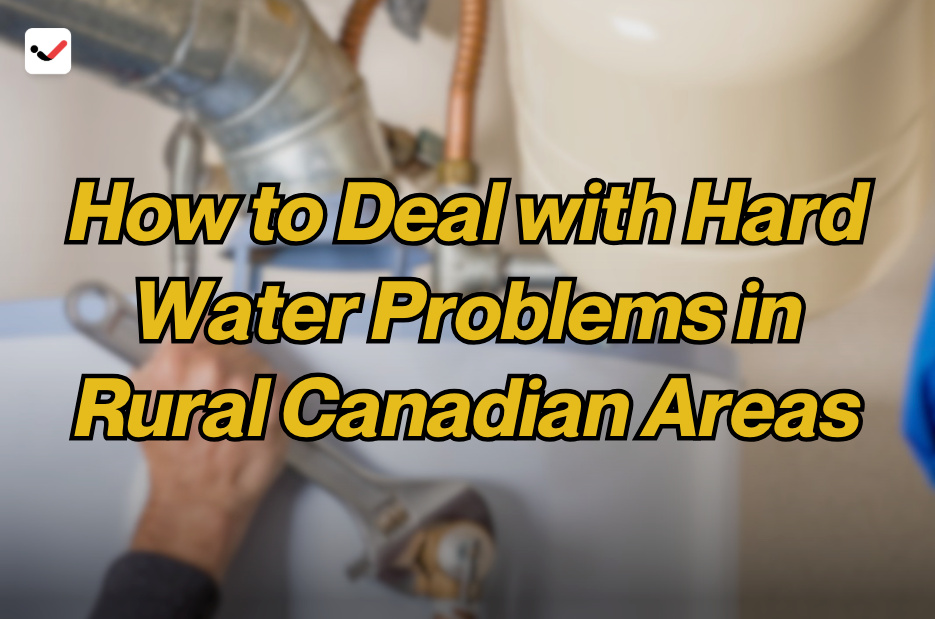How to Deal with Hard Water Problems in Rural Canadian Areas
How to Deal with Hard Water Problems in Rural Canadian Areas

In many rural parts of Canada, hard water is a common problem. Hard water means the water has a high level of minerals, mostly calcium and magnesium. These minerals are not harmful to your health, but they can cause big issues in your home. From clogged pipes and broken appliances to dry skin and dull hair, hard water can quietly damage everyday life over time.
People living in rural areas usually get their water from private wells. Unlike city water, well water isn’t treated by municipal systems, so it often contains more minerals. This makes it even more important for rural homeowners to know how to identify hard water and fix the problems it causes. In this article, we’ll explain how to recognize hard water, the effects it has, and practical ways to treat and manage it in a rural Canadian setting.
What is Hard Water?
Hard water contains high levels of dissolved calcium and magnesium. These minerals are picked up when water moves through limestone, chalk, or gypsum deposits underground. The harder the water, the more problems it can cause around the house. Many rural homes in provinces like Alberta, Saskatchewan, and Ontario face this issue regularly, especially those using groundwater from wells.
Hard water can be measured in grains per gallon (GPG) or milligrams per litre (mg/L). Water with more than 7 GPG (or 120 mg/L) is usually considered hard. You can use a hard water test kit or send a water sample to a lab to find out the exact hardness of your water.
Common Signs of Hard Water
If you live in a rural home and use well water, you may already be seeing the signs of hard water:
White spots on dishes and glassware
Soap that won’t lather easily
Skin and hair feeling dry after showering
Rust stains or white buildup around faucets and showerheads
Washing machine or dishwasher breaking down often
Reduced water pressure from clogged pipes
These signs may seem small at first, but over time, they can cost you money and damage your home.
How Hard Water Affects Rural Homes
In rural areas, where people often rely on private water systems, hard water can wear out water heaters, washing machines, and dishwashers much faster than expected. Scale buildup inside pipes and appliances reduces efficiency, increases energy bills, and shortens the lifespan of household systems. That means more frequent repairs or replacements.
Hard water can also stain toilets, bathtubs, and sinks with mineral deposits that are difficult to clean. On top of that, using hard water for laundry can make clothes feel stiff and look faded after a few washes.
Testing for Hard Water
The first step to solving hard water problems is testing. In Canada, you can find reliable water testing services through your provincial health department or private labs. You can also buy at-home test strips at hardware or home improvement stores. Testing your water will give you a clear idea of its mineral content and help you choose the best treatment option.
If your water test also shows the presence of iron, manganese, or other elements, you may need a more advanced filtration system in addition to a water softener.
Water Softener Systems
One of the most effective solutions to hard water is installing a water softener. This system removes calcium and magnesium ions through a process called ion exchange, replacing them with sodium or potassium. There are different types of water softeners available:
Salt-based water softeners – Most common, effective for high hardness levels
Salt-free water softeners – Use a filter or conditioner to reduce scaling, but don’t remove minerals completely
Dual-tank softeners – Good for larger households that use a lot of water
Portable softeners – Ideal for cottages, cabins, or seasonal use
Make sure to choose a system that fits your water usage and hardness level. It’s also important to install it correctly—ideally where the water enters your home so that all your water is treated.
Maintenance and Costs
Water softeners need regular care to keep working well. Salt tanks should be refilled when low, usually once a month. Some systems also require occasional cleaning to remove iron buildup or bacteria, especially in well water systems.
While water softeners come with an upfront cost, they save money over time by protecting your plumbing, appliances, and clothes. In rural Canada, many homeowners consider it a smart investment.
Other Hard Water Treatment Options
In some cases, especially where people want to reduce sodium intake or where space is limited, homeowners may look for alternatives to traditional water softeners. These include:
Reverse osmosis systems – Remove many minerals and contaminants but are better for drinking water than whole-house treatment
Magnetic or electronic descalers – Claim to reduce scaling without removing minerals, but results can vary
Whole-house filtration systems – Sometimes used in combination with softeners to deal with iron, sulfur, or other well water problems
Each method has pros and cons, and the right choice depends on your budget, water quality, and household needs.
Simple Tips to Manage Hard Water Day-to-Day
Even with a softener, there are daily steps you can take to reduce the impact of hard water:
Use vinegar to remove limescale buildup on taps and fixtures
Add baking soda to laundry loads to help soften clothes
Use moisturizing shampoos and soaps to reduce skin and hair dryness
Clean out your water heater once a year to remove mineral buildup
Check appliances like coffee makers and humidifiers for scale
These small habits can help you protect your home and health from hard water problems.
When to Call a Professional
If you're not sure what’s causing water problems in your rural home, it’s worth calling a local plumber or water treatment expert. They can test your water, recommend the right equipment, and install it safely. Some areas in Canada even offer rebates or assistance programs to help homeowners manage water quality issues.
Hard water is a common issue for rural Canadians, but it doesn’t have to be a costly one. With the right tools and knowledge, you can take control of your water quality. Whether it’s installing a water softener, maintaining your plumbing, or adopting simple cleaning habits, dealing with hard water is completely manageable.
Rural homes face unique water challenges, but reliable solutions are available. Testing your water, choosing the right softener system, and doing regular upkeep can protect your home, your health, and your wallet in the long run.

